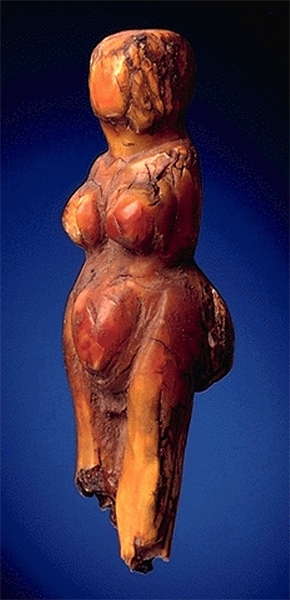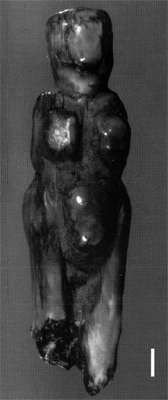Back to Don's Maps
Back to Venus figures from the Stone Age
The Brown Ivory Figurine, Figurine en ivoire brun. or Abrachiale, a venus of fossilised ivory from Balzi Rossi
The Brown Ivory Figurine, Figurine en ivoire brun, or Abrachiale, is a nearly complete female figurine made from partially fossilised ivory found at Balzi Rossi and measures 67.6 mm high. A thick coat of varnish applied by Jullien, its discoverer, has given it a red to yellowish-red color, making it impossible to tell if red ochre had ever been applied to its surface. The nearly circular head lacks any indication of facial features or hair and no arms or hands are present. The roughly hemispherical breasts are large and separated from each other by a deep groove. Protruding even more than the breasts is the oval-shaped enlarged abdomen. The pubic region of this figurine is highly unusual because a deep U-shaped groove 8.5 mm wide extends from the mid-thigh into the crotch, and centred in this groove, at the base of the abdomen, is a small, carefully carved ridge in the form of an inverted crescent which is in the correct position to represent enlarged labia minora.
This nearly complete female figurine known as either 'the brown ivory figurine' or 'Abrachiale' is made from partially fossilised ivory and measures 67.6 mm high. A thick coat of varnish applied by Jullien, its discoverer, has given it a red to yellowish-red color, making it impossible to tell if red ochre had ever been applied to its surface.
The nearly circular head lacks any indication of facial features or hair and no arms or hands are present. The roughly hemispherical breasts are large and separated from each other by a deep groove. Protruding even more than the breasts is the oval-shaped enlarged abdomen. The pubic region of this figurine is highly unusual because a deep U-shaped groove 8.5 mm wide extends from the mid-thigh into the crotch, and centred in this groove, at the base of the abdomen, is a small, carefully carved ridge in the form of an inverted crescent which is in the correct position to represent enlarged labia minora.
The figurine was carved in ivory which raises interesting problems since mammoths were not living at the time in Italy and finding their remains is rare. Scholars have speculated that the ivory figurines were either carved far from Italy and then transported to the Mediterranean shores or carved on the spot (or near it) using imported raw material. As a result of this scarcity, ivory items of any kind are exceedingly rare in Ligura, Italy, and in southeastern France.
Photo: © Harry Foster
Text: Jennett (2008)

Front view of the Figurine in Brown Ivory (coll. Bolduc).
Scale : 5 mm.
This statuette is a figurine in almost completely mineralised ivory. Its height is 67.7 mm. The width at the chest is 17.2 mm and 20 mm at the hips. The maximum thickness between the buttocks and the front of the belly is 22.7 mm. Its weight is 19.37 g.
Photo: R. White
Text: White et Bisson (1998)


Colours shown here are Munsell = 2.5YR 5/8, Moderate orange red (left) and 5YR 5/8 Moderate orange (right)
rgb equivalents (on the 0-255 scale) 183,101,66 and 178,104,54
Data from http://www.perbang.dk/
Because of the yellowish color of this piece (Munsell = 2.5YR 5/8 to 5YR 5/8, Moderate orange red to Moderate orange), it is difficult to say whether there are traces of ochre on the surface. Cracks due to drying of the raw material and filled with dark sediment, are visible on the head and the legs (back and bottom). The only injury suffered by the statue is a small broken area on the tip of the right breast.
When viewed from the front, the head is almost circular. It is not tilted slightly downwards as can be seen on some other female figures. No facial features or representation of the hair is visible. The back of the head is narrower than the front. A deep polished groove on the back of the neck emphasises it. This groove continues to the front of the neck, marking the shoulders and suggesting the clavicles. There are neither arms nor hands. The breasts are irregularly hemispherical and separated from each other by a deep groove.
The back of the chest is flat with a shallow incision indicating, perhaps, the region of the spine. The waist is formed by a broad depression. The abdomen is oval, and is much more prominent than the breasts. It is marked off from the hips by two lateral incisions. The volume of the buttocks is very broad and they appear spherical seen from behind. They are separated by a deep but very narrow incision. The lower limbs are well shaped. The break at the knees apparently dates from the prehistorical period.
The pubic area is very unusual. Most of the statuettes of Grimaldi have a protruding mons pubis of exaggerated size with a groove or a vertical incision showing the vulva. In this piece, a deep U shaped groove, 8.5 mm wide, runs from mid-thigh to crotch. In the centre of this groove, just below the abdomen, is a small elongated horizontal slightly curved ridge. This ridge, which has not been completely cleaned of sediment, is in the place where the labia minora would be. This way of representing the genitalia has not been previously observed in other female figures of Upper Paleolithic Europe.
Text above: White et Bisson (1998)
![]() Figurine d'ivoire surnommée "L'Abrachiale", des grottes dei Balzi
Rossi (Ligurie - Italie) - copyright Pierre Bolduc-Montréal-Canada.
Figurine d'ivoire surnommée "L'Abrachiale", des grottes dei Balzi
Rossi (Ligurie - Italie) - copyright Pierre Bolduc-Montréal-Canada.
Figurine of mammoth ivory called "Abrachiale", from the caves of Balzi Rossi (Ligurie - Italy) - copyright Pierre Bolduc-Montreal-Canada.
The name means "without arms".
On the back can be seen a fine line being used to outline the spinal column. The breaks on the legs are both very old with some more recent ones. The figurine is 67.6 mm in height.
Photo and French text: "les mammouths - Dossiers
Archéologie - n° 291 - Mars 2004"
My thanks to Anya for access to this resource.
References
- Cohen C., 2003: La femme des origines. Images de la femme dans la préhistoire occidentale,, Paris, Belin-Herscher, 2003, 191 pages.
- Jennett K., 2008: "Female Figurines of the Upper Paleolithic" (2008), University Honors Program Paper 74. http://ecommons.txstate.edu/honorprog/74
- White, R., Bisson M., 1998: Imagerie féminine du Paléolithique : l'apport des nouvelles statuettes de Grimaldi, Gallia préhistoire. Tome 40, 1998. pp. 95-132.